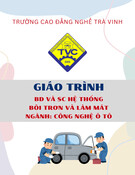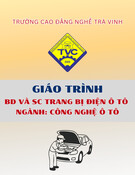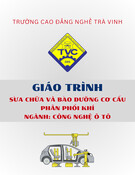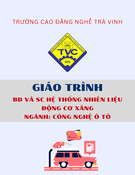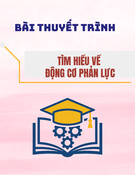
* Corresponding author.
E-mail addresses: febrahimy@eng.ikiu.ac.ir (F. Ebrahimi)
© 2015 Growing Science Ltd. All rights reserved.
doi: 10.5267/j.esm.2015.1.002
Engineering Solid Mechanics 3 (2015) 131-141
Contents lists available at GrowingScience
Engineering Solid Mechanics
homepage: www.GrowingScience.com/esm
Small-scale effects on transverse vibrational behavior of single-walled carbon
nanotubes with arbitrary boundary conditions
Farzad Ebrahimi* and Parisa Nasirzadeh
Department of Mechanical Engineering, Faculty of Engineering, Imam Khomeini International University, Qazvin, Iran
A R T I C L E I N F O A B S T R A C T
Article history:
Received September 6, 2014
Accepted 15 January 2015
Available online
16 January 2015
In the present paper, the differential transformation method is employed to develop a semi
-
analytical solution for free transverse vibration of single-walled carbon nanotube (SWCNT)
with arbitrary boundary conditions. The small scale effect is taken into consideration via
Eringen’s nonlocal elasticity theory while the transverse shear deformation effects and rotary
inertia are taken into account in presented Timoshenko beam theory. Through variational
formulation and the Hamilton's principle the governing differential equations and the boundary
conditions are derived and then solved by a semi-analytical method called differential
transformation method (DTM) for various frequency modes of beams and different edge
conditions. Comparisons made between the present results and results reported by well-known
references for special cases treated before, have confirmed accuracy and efficiency of the
presented approach. The effects of several parameters such as transverse shear deformation
effects, slenderness ratios, boundary conditions and small scale on vibration characteristics of
SWCNT are examined. The present study illustrates that the vibration characteristics of an
SWCNT are strongly dependent on the small scale parameters.
© 201
5
Growing Science Ltd. All rights reserved.
Keywords:
Free vibration
Nanobeam
Eringen nonlocal elasticity theory
1. Introduction
The differential transformation method is an efficient and useful numerical method for the rapid
solutions of linear and non-linear partial differential equations. It is an alternative discrete approach to
directly solve the governing equations of various engineering problems. This method first proposed by
Zhou (1986) in solving linear and non-linear initial value problems in electrical circuit analysis. Due to
its simplicity and accuracy, DTM has been widely employed in many areas of industry and
mathematics. Several researchers have addressed the linear and nonlinear static and dynamic problems
of beams and plates by DTM but its application in micro- and nano-scale beams and tubes problems is
scarce.

132
Nanoscale engineering materials have significant mechanical, electrical and thermal performances
that are superior to the conventional structural materials. They have attracted great interest in modern
science and technology after the invention of carbon nanotubes (CNTs) by Iijima (1991). For example,
in micro/nano electromechanical systems (MEMS/NEMS); nanostructures have been used in many
areas including communications, machinery, information technology, biotechnology technologies. So
far, three main methods were provided to study the mechanical behaviors of nanostructures: atomistic
model (Baughman et al., 2002), semi-continuum (Li & Chou, 2003) and continuum models (Wang and
Cai, 2006). However, both atomistic and semi-continuum models are computationally expensive and
are not suitable for analyzing large scale systems. In other words, since conducting experiments at the
nanoscale is a daunting task, and atomistic modeling is restricted to small-scale systems owing to
computer resource limitations, continuum mechanics offers an easy and useful tool for the analysis of
CNTs. Therefore, there are considerable efforts made to develop and calibrate continuum structural
models for CNTs analysis and these efforts have been summarized in the previous papers.
Moreover due to the inherent size effects, at nanoscale, the mechanical characteristics of
nanostructures are often significantly different from their behavior at macroscopic scale. Such effects
are essential for nanoscale materials or structures and the influence on nano-instruments is great
(Maranganti and Sharma, 2007). Generally, theoretical studies on size effects at nanoscale are by means
of surface effects (Zhu et al., 2009), strain gradients in elasticity (Mindlin, 1964) and plasticity
(Aifantis, 1984), and the nonlocal stress field theory (Eringen, 1983; 1972a). Unfortunately, the
classical continuum theories are deemed to fail for these nanostructures, because the length dimensions
at nano scale are often sufficiently small such that call the applicability of classical continuum theories
into the question. Consequently, the classical continuum models need to be extended to consider the
nanoscale effects and this can be achieved through the nonlocal elasticity theory proposed by Eringen
(Eringen, 1972a) which considers the size-dependent effect. According to this theory, the stress state
at a reference point is considered as a function of strain states of all points in the body. This nonlocal
theory is proved to be in accordance with atomic model of lattice dynamics and with experimental
observations on phonon dispersion (Eringen, 1983). In nonlocal theory, the nonlocal nanoscale in the
constitutive equation could be considered simply as a material-dependent parameter.
In recent years, nanobeams and carbon nanotubes hold a wide variety of potential applications
(Zhang et al., 2004; Wang, 2005; Wang and Varadan, 2006) such as sensors, actuators, transistors,
probes, and resonators in NEMSs. Thus, establishing an accurate model of nanobeams is a key issue
for successful NEMS design. As a result, nanotechnological research on vibrational properties of
nanobeams is important because such components can be used as design components in nano-sensors
and nano-actuators. Furthermore, many researchers worked on bending, buckling and vibration of
beam-like elements in nanoscale (Peddieson et al., 2003; Liew et al., 2008; Amara et al., 2010) in most
of which the nonlocal Euler-Bernoulli beam theory has been employed for vibration analysis of
nanobeams (Lu et al., 2006; Zhang et al., 2005; Xu, 2006). Samaei and Mirsayar (2011) considered the
small scale effects on buckling characteristics of multi-walled CNTs. Kiani (2010) presented a meshless
approach for free transverse vibration analysis of embedded SWCNTs with arbitrary boundary
conditions accounting for nonlocal effect. Also But since this theory does not account for transverse
shear and rotary inertia effects, it gives unreliable results and overpredicts the vibration characteristics
for stubby beams and especially for higher frequencies of vibration because the effect of transverse
shear deformation become significant and cannot be neglected (Wang et al., 2000). Employing nonlocal
Timoshenko beam model Ansari and Ramezannezhad studied the large-amplitude vibrations of
embedded multi-walled CNTs including thermal effects (Ansari & Ramezannezhad, 2011). Kiani and
Mehri (2010) examined the behaviour of nanotube structures under a moving nanoparticle using
nonlocal beam theories. Besides, Torabi and Nafar Dastgerdi (2012) presented an analytical method
for free vibration analysis of Timoshenko beam theory applied to cracked nanobeams using a nonlocal
elasticity model. While Ansari et al. (2011) presented a sixth-order compact finite difference method
for vibrational analysis of nanobeams embedded in an elastic medium based on nonlocal beam theory.

F. Ebrahimi and P. Nasirzadeh / Engineering Solid Mechanics 3 (2015)
133
Ghorbanpourarani et al. (2010) considered the cylindrical shell and beam models to study transverse
vibration of short CNTs. Recently Ansari and Sahmani (2012) investigated the small scale effect on
vibrational response of SWCNTs with different boundary conditions based on nonlocal beam models.
Most recently Kiani (2013) presented the vibration analysis of elastically restrained double-walled
CNTs on elastic foundation subjected to axial load using nonlocal shear deformable beam theories.
Motivated by these considerations, in this study, differential transformation method is applied in
analyzing vibration characteristics of SWCNTs under various edge conditions. The superiority of the
DTM is its simplicity and good precision and depends on Taylor series expansion while it takes less
time to solve polynomial series. It is different from the traditional high order Taylor’s series technique,
which needs symbolic competition of the necessary derivatives of the data functions. The Taylor series
method is computationally taken long time for large orders. With this technique, it is possible to reach
highly reliable results or even exact solutions for differential equations. With this method, the given
partial differential equation and related initial conditions are transformed into a recurrence equation,
which could eventually lead to the solution of a system of algebraic equations as coefficients of a power
series solution. This helps obtain exact and approximate solutions of linear and nonlinear ordinary and
partial differential equations and there is no necessary for linearization or perturbations, large
computational work and round-off errors are avoided. It’s a proper technique to analyze beam
vibrations. To the author’s best knowledge there is no work reported on the application of DTM on
vibration analysis of SWCNTs based on nonlocal Timoshenko bema model. In this study, the governing
equations and boundary conditions for the free vibration of a nonlocal Timoshenko beam have been
extracted via Hamilton principle. Unlike the Euler beam model, the Timoshenko beam model helps for
the effect of transverse shear deformation, which becomes significant for CNTs with small length-to-
diameter ratios. The detailed mathematical derivations are presented and numerical investigations are
performed while the emphasis is placed on investigating the impact of different parameters such as
transverse shear deformation effects, slenderness ratios, boundary conditions and small scale on
vibration characteristics of SWCNT. Comparisons with the results from the existing literature are
provided and the good agreement between the results of the proposed method of this paper and those
available in literature validated the presented approach. Numerical results are presented to serve as
benchmarks for the application and the design of nanoelectronic and nano-drive devices, nano-
oscillators, and nanosensors, in which CNTs act as basic elements.
2. Brief statement of the differential transformation method
Differential transformation technique is one of the useful techniques to solve the differential
solutions with small calculation errors and ability to solve nonlinear equations with boundary
conditions value problems. Abdel-Halim Hassan (2002) used the DTM on eigenvalues and normalized
eigenfunctions. In addition, Wang (2013) presented the axial vibration analysis of stepped bars utilizing
DTM. The DTM is proved to be an appropriate computational tool for different engineering problems.
Using differential transformation technique, the ordinary and partial differential equations can be
transformed into algebraic equations, from which a closed-form series solution can be obtained easily.
In this method, certain transformation rules are used to both the governing differential equations of
motion and the boundary conditions of the system in order to transform them into a set of algebraic
equations as presented in Table 1 and Table 2. The solution of these algebraic equations gives the
desired results of the problem. The basic definitions and the application procedure of this method can
be introduced as follows:
The transformation equation of function f(x) can be defined as (Chen and Ju, 2004):
[
]
=
1
/
!
(
(
)
)
(1)

134
where f(x)is the original function and F[k]is the transformed function. The inverse transformation is
defined as:
(
)
=
(
−
)
∞
[
]
(2)
Table 1. Some of the transformation rules of the one-dimensional DTM (Chen and Ju, 2004)
Original function
Transformed function
(
)
=
(
)
±
ℎ
(
)
(
)
=
(
)
±
(
)
(
)
=
(
)
(
)
=
(
)
(
)
=
(
)
ℎ
(
)
(
)
=
(
−
)
(
)
(
)
=
(
)
(
)
=
(
+
)
!
!
(
+
)
(
)
=
(
)
=
(
−
)
=
o
if
k
≠
n
=1 if k=n
Table 2. Transformed boundary conditions (B.C.) based on DTM (Chen and Ju, 2004)
X=0 X=1
Original B.C.
Transformed B.C.
Original B.C.
Transformed B.C.
(
0
)
=
0
[
0
]
=
0
(
1
)
=
0
[
]
=
0
∞
(
0
)
=
0
[
1
]
=
0
(
1
)
=
0
[
]
=
0
∞
(
0
)
=
0
[
2
]
=
0
(
1
)
=
0
(
−
1
)
[
]
=
0
∞
(
0
)
=
0
[
3
]
=
0
(
1
)
=
0
(
−
1
)
(
−
2
)
[
]
=
0
∞
Combining Eq. (1) and Eq. (2) one obtains:
(
)
=
(
−
)
!
(
(
)
)
∞
(3)
In actual application, the function f(x)is expressed by a finite series and Eq. (3) can be written as
follows:
(
)
=
(
−
)
!
(
(
)
)
(4)
which implies that the term in relation (5) is negligible.
(
)
=
(
−
)
!
(
(
)
)
∞
(5)

F. Ebrahimi and P. Nasirzadeh / Engineering Solid Mechanics 3 (2015)
135
3. Nonlocal Timoshenko beam equations and boundary conditions
Consider a beam with length L and the cross sectional area of A. Based on Timoshenko beam
theory, strain-displacement and strain energy relations are as follows (Wang et al., 2000):
=
∅
,
(6)
=
∅
+
(7)
=
1
/
2
(
+
)
(8)
where x is the longitudinal coordinate measured from the left end of the beam and the z is the coordinate
measured from the mid-plane of the beam, w represents the lateral deflection and ∅ is the bending
slope of the beam due to bending and ε is the normal strain and γ is the transverse shear strain and
U represents the strain energy. σ and σ are normal stress and the transverse shear stress respectively.
After substituting Eq. (5) and Eq. (7) in Eq. (8) and putting bending moment and shear force in Eq. (8),
strain energy is written as:
=
1
/
2
(
∅
+
(
∅
+
)
)
=
1
/
2
(
∅
+
(
∅
+
)
)
(9)
=
(10)
=
(11)
where M and Q are bending moment and the shear force respectively. The kinetic energy T, by
assuming free harmonic motion and rotary inertia effect, is written as:
=
1
/
2
(
+
∅
)
(12)
whereω is the circular frequency of vibration and ρ and I are the mass density and the second moment
of area of the beam respectively. Applying Hamilton’s principle (Chow, 2013) requires:
(
−
)
=
0
=
(
−
∅
−
∅
+
+
+
∅
∅
)
(13)
and after performing integration by parts, we reach:
0
=
−
+
∅
∅
+
+
−
[
∅
]
−
[
]
(14)
This results in the following equations:
=
−
∅
(15)
=
−
(16)
and the boundary conditions are in two forms as below relations:

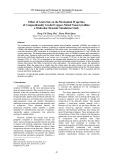
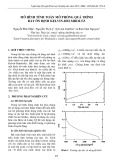
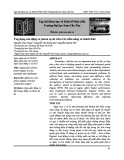

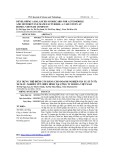



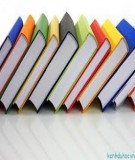
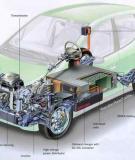
![Giáo trình Công nghệ sửa chữa và bảo dưỡng ô tô - Trường Đại học Công nghiệp Việt - Hung [Mới nhất]](https://cdn.tailieu.vn/images/document/thumbnail/2025/20251201/gmducdat11a4@gmail.com/135x160/65741764643914.jpg)


